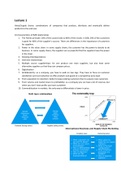Samenvatting
Summary IBSCM Lectures (International Bus. & Supply Chain)
- Instelling
- Rijksuniversiteit Groningen (RuG)
The summary includes all notes of the lectures, including graphs and figures for a better understanding of the topics. Next to that, this is a summary of the articles that were discussed in the lecture. This summary contains all key topics that you need to understand and study for the exam of the c...
[Meer zien]




